The Big Internet Math-Off 2024, Quarter-final 3
The Aperiodical 2024-07-12
Here’s the third quarter-final match of The Big Internet Math-Off. Today, we’re pitting Fran Watson against Fran Herr. It’s an extravafranza!
Take a look at both pitches, vote for the bit of maths that made you do the loudest “Aha!”, and if you know any more cool facts about either of the topics presented here, please write a comment below!
Fran Watson – Learn about rotation
Fran invites you to hum along, join in with the actions or just listen and enjoy!
 Fran Watson is a teacher and communicator of mathematics originally hailing from Cornwall but now living in Cambridgeshire (by way of Cardiff in between – locations today brought to you by the letter C!) She loves puzzles, origami, games and musical theatre and will endeavour to weave these passions into her pitches.
Fran Watson is a teacher and communicator of mathematics originally hailing from Cornwall but now living in Cambridgeshire (by way of Cardiff in between – locations today brought to you by the letter C!) She loves puzzles, origami, games and musical theatre and will endeavour to weave these passions into her pitches.
Fran Herr – All knotted up
Take a long paper strip, twist one end \(180^{\circ}\), and attach the short endswith some tape. This produces a Möbius loop.

If have spent some time in the math communication world, you mightknow the result of cutting this shape along the center line. But, ifthis is new for you, take a moment and try the experiment for yourself!(Or just watch the video below.)
Why do we get only one loop? My favorite explanation is to view theresulting longer loop as a thickened version of the boundary of theMöbius loop. This experiment tells us that the boundary of the Möbiusloop is a single unknotted circle.
Consider repeating this process with more twists. For a Möbius loopwith \(k\) half-twists, what is theresult of cutting it in half? If you want to know the answer in fullgenerality, I made a video on thisexact topic a few years ago. I will demonstrate one more example here: athrice-twisted Möbius loop.
This little activity tells us that the boundary of the thrice-twistedMöbius loop is the trefoil knot. Have I surprised you yet?
A mathematical knot is an continuous embedding of the circle into \(\mathbb R^3\). Think of a piece of string with the ends attached. Two knots are the same (ambiently isotopic) if you can “wiggle them around” in \(\mathbb R^3\) to look the same. We can also have links which are embeddings of a finite disjoint collection of circles into \(\mathbb R^3\). I will often abuse terminology and call them all “knots”. Some of my favorite examples are below.
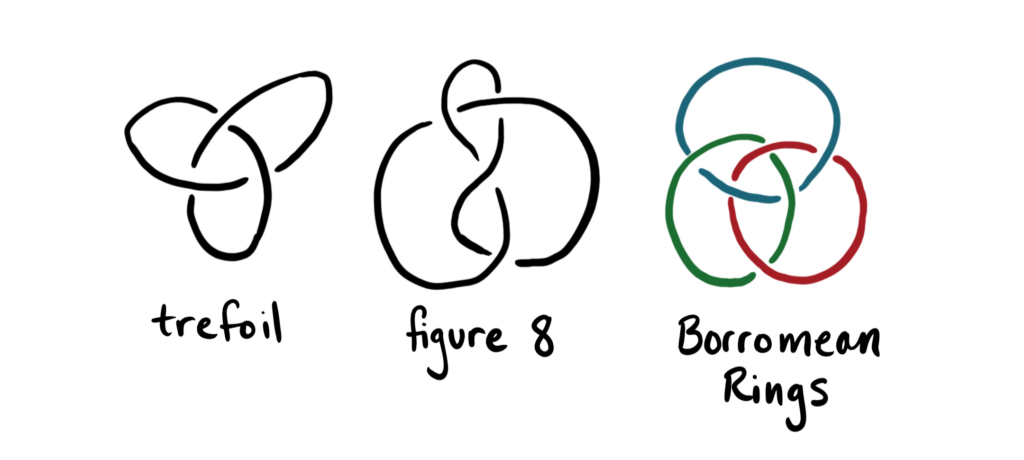
Knots are a bit squirrely in character. For example, mathematiciansdon’t yet know an algorithm to tell if two knots are the same! One wayto study knots is to instead study a Seifert surface of a knot.This is an (orientable)surface with the given knot (or link) as the boundary. Although the“orientable” condition does have some uses, it doesn’t matter for ourpurposes so we will consider both orientable and non-orientable Seifertsurfaces. Our investigation above reveals that the thrice-twisted Möbiusloop is a (non-orientable) Seifert surface for the trefoil knot.
Given a knot, there is a simple algorithm to generate a correspondingSeifert surface (two surfaces, in fact). First draw a planar knotdiagram which sections the plane into different faces. We can colorthese faces red and blue in an alternating way so that no two facessharing a bounding edge are the same color.
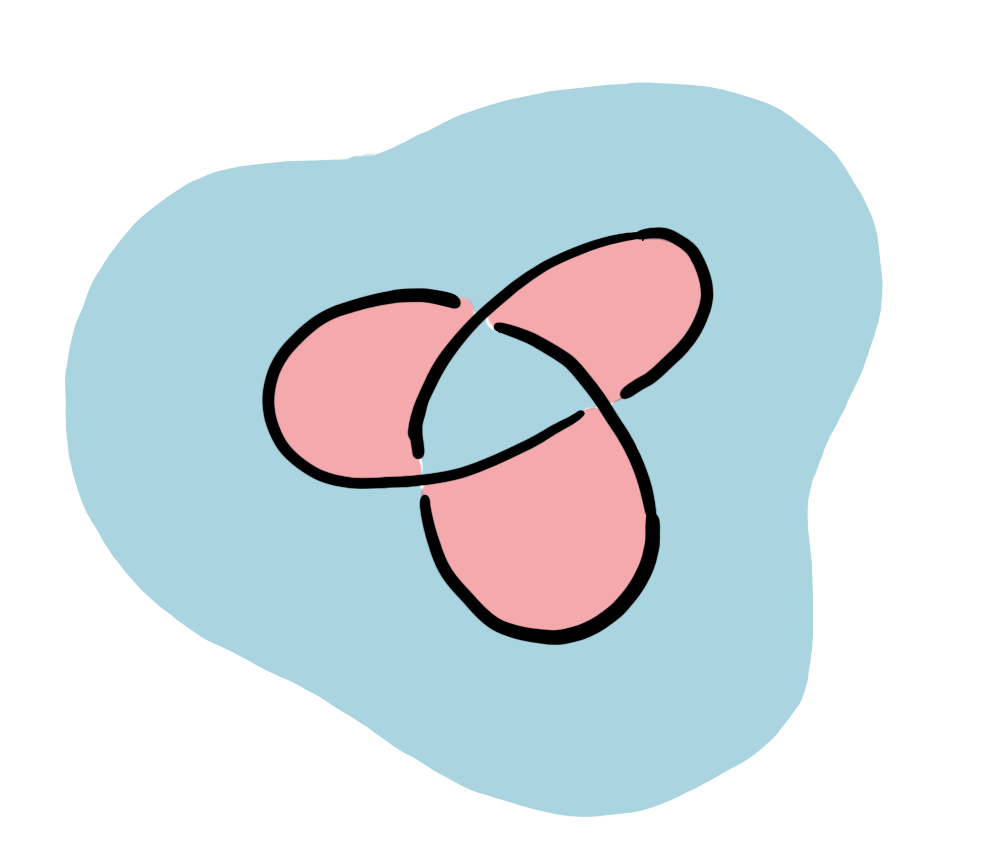
Place a vertex in each red face and connect each pair of verticesonce for each crossing between the corresponding faces. Mark these edges\(L\) or \(R\) for a left-hand or right-hand twist.Repeat with the blue faces. Then we have generated two planar graphswhich are dual toeach other by construction. Each of these graphs encode a Seifertsurface. Place a disk at each vertex of the graph and a twisted bandwith a right or left twist for each edge. We are left with a surfacethat has the given knot as a boundary.
 Examples of left and right hand crossings for the knotdiagram. They correspond with twisting a band is the indicateddirection.
Examples of left and right hand crossings for the knotdiagram. They correspond with twisting a band is the indicateddirection.
Consider the example above for the trefoil knot. The red graphrepresents the thrice-twisted Möbius loop; the blue graph provides analternative Seifert surface. The trefoil is an alternatingknot, meaning that all its crossings have the same orientation.Thus, we have omitted the left/right labeling for this example.
Last year I became acquainted with Shiying Dong’s fantastic work intopological crochet. Shiying constructs Seifert surfaces with naturalcrochet principles by performing a sort of inverse of the processdescribed above. She starts with a graph— some vertices and edges— andimagines each edge as a “ribbon” with thickness. Then she applies aright-hand twist to each edge and reattaches it. If she starts with theblue graph in the figure above (consisting of two vertices with threeedges between them), she obtains the orientable Seifert surface for thetrefoil.
 A crocheted orientable Seifert surface of thetrefoil.
A crocheted orientable Seifert surface of thetrefoil.This is the first crochet project that I learned from Shiying and the first that she teaches in her workshops. You can learn to make one for yourself with my tutorial video or the videos on Shiying’s channel! But without yarn and a crochet hook on hand, we can perform the same process on a graph using pen and paper.
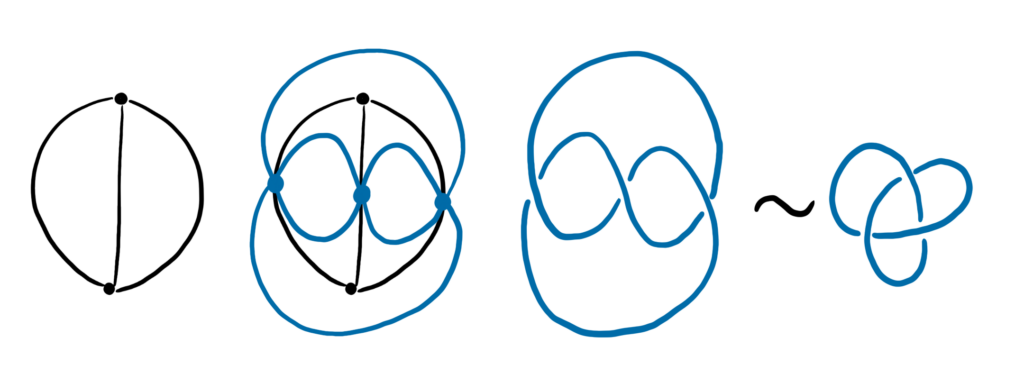 The graph algorithm performed to obtain the orientabletrefoil Seifert surface.
The graph algorithm performed to obtain the orientabletrefoil Seifert surface.For a general planar graph, the steps are as follows.
Draw a planar graph \(G\). It can have double edges and loops, but no edges should cross. The cyclic order of the edges at each vertex is fixed by the embedding into the plane.
We will construct a new graph \(H\). Put a vertex of \(H\) on each edge of \(G\) in a new color.
A given edge of \(G\) has four “neighboring edges”. If the endpoints of edge \(e\) are vertices \(v\) and \(w\), then the neighboring edges of \(e\) are on its right and left sides in the cyclic order at each vertex \(v\) and \(w\). Some edges may be double counted.
Add an edge in \(H\) between two vertices if the corresponding edges in \(G\) are neighbors. Each vertex in \(H\) should have degree 4.
At each vertex of \(H\), draw a right-handed crossing.
You are left with a knot or a link!
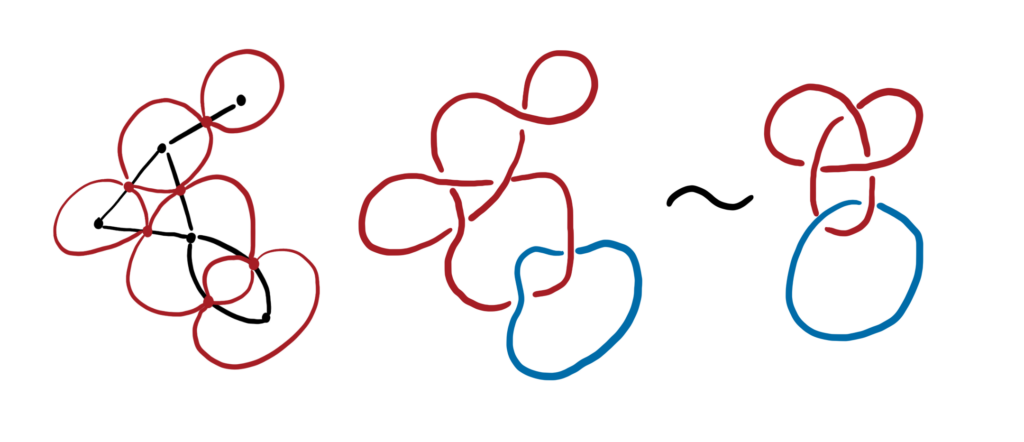 The graph algorithm performed on a randomgraph.
The graph algorithm performed on a randomgraph.In this process, we have made a universal choice for the handednessof each crossing. This means that all knots and links generated in thisway will be alternating. A modification would be to choose thehandedness of each crossing individually.
I have really enjoyed trying this on my favorite graphs. Sometimesthe resulting knot is surprising and reveals an unexpected connection.In general, it seems difficult to determine which knot or link weobtain—or even the number of link components.
What are the next graphs that you would try? Here, I’ll choose theedge graphs of the Platonic solids. Let’s start with the tetrahedron.Draw four vertices and connect every pair of vertices with an edge. Whatlink do we get when we apply with the process above?
 A crocheted version of the Seifert surface resulting fromthe tetrahedron.
A crocheted version of the Seifert surface resulting fromthe tetrahedron.Try for yourself and you will see that we meet another old friend:the Borromean rings. If we continue with the other platonic solids, weobtain two more woven links, one for the cube/octahedron, and one forthe icosahedron/dodecahedron. (Recall that dual graphs will give thesame link.) These links can be nicely woven by pipe cleaners; thanks tomy friend Elliot Kienzle for pointing that out!
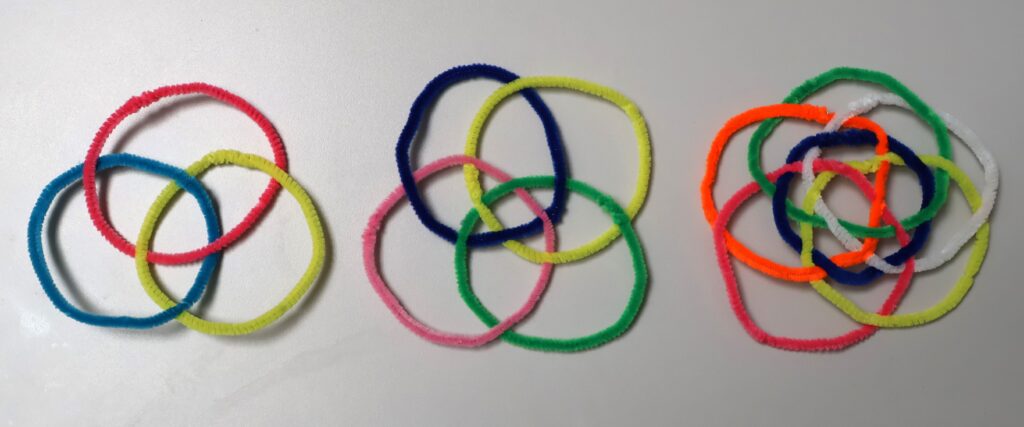
Some other great examples to try are the wheel graphs andthe edge graphs of prisms.What corresponding graphs and knots can you find? Whether you engagewith this question by crocheting surfaces or by doodling graphs, thereare many surprises and delights to be found.
 The Seifert surface generated using the edge graph of thecube (left) and the surface from the edge graph of the tetrahedron(right).
The Seifert surface generated using the edge graph of thecube (left) and the surface from the edge graph of the tetrahedron(right). Fran Herr is a PhD student in mathematics at the University of Chicago. She studies low dimensional topology and geometric group theory. You can follow her on YouTube and X.
Fran Herr is a PhD student in mathematics at the University of Chicago. She studies low dimensional topology and geometric group theory. You can follow her on YouTube and X.
So, which bit of maths has tickled your fancy the most? Vote now!
Note: There is a poll embedded within this post, please visit the site to participate in this post's poll.The poll closes at 08:00 BST tomorrow. Whoever wins the most votes will get the chance to tell us about more fun maths in the semi-final.
Come back tomorrow for the last quarter-final match, pitting Ayliean against Dave Richeson, or check out the announcement post for your follow-along wall chart!